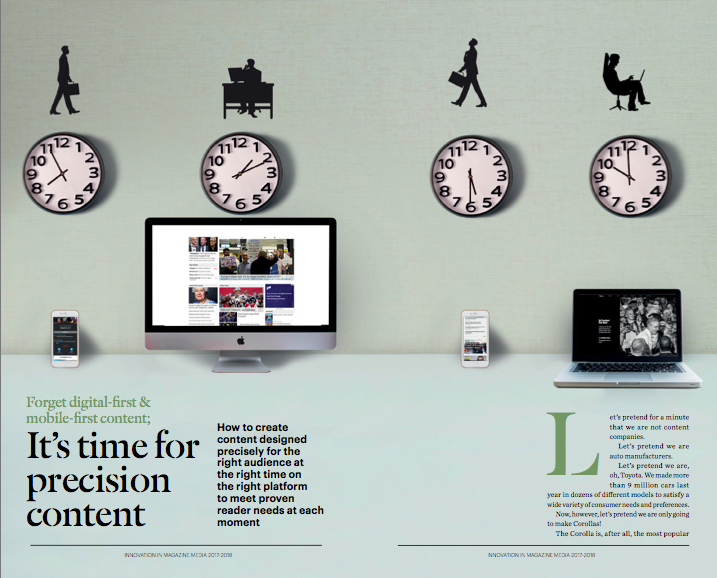
25 Sep It’s time for precision content
How to create content designed precisely for the right audience at the right time on the right platform to meet proven reader needs at each moment
Let’s pretend for a minute that we are not content companies.
Let’s pretend we are auto manufacturers. Let’s pretend we are, oh, Toyota. We made more than 9 million cars last year in dozens of different models to satisfy a wide variety of consumer needs and preferences. Now, however, let’s pretend we are only going to make Corollas!
The Corolla is, after all, the most popular name plate in the history of the world in terms of car sales.
To fulfill consumers’ different needs, we would simply re-brand the Corolla three different ways: marketing it as Corolla-City, Corolla-Off-Road, Corolla-Suburban.
Imagine how much easier and more profitable that would be for us.
Consumer pushback? No worries: Toyota is such a popular brand, our marketing could convince consumers to adjust.
Uh, no. They wouldn’t. They’d revolt.
The Corolla is not built for hurly-burly off- road situations. Nor is it built for suburban mums transporting large groups of kids. Nor does it have any sex appeal. None.
Consumers need different products to satisfy different needs. A one-product strategy would be suicidal.
Our content is often a one-product offering.
Yet, as content producers we often do exactly that — we create one “product” for desktop or print, and then expect it to work in other, completely different “use cases” and platforms. All the platforms — desktops, laptops, mobile, distributed platforms, social media, wearables, tablets — have their own unique properties and are used by readers for different purposes.
To make matters worse, we also do not differentiate our product for the consumer’s unique needs at different times of the day — the morning rush, mid- day updates, evening planning, night-time lean-back.
How are we not then as suicidal as a one-model Toyota company would be?
We too often embody automaker Henry Ford’s infamous remark that early Ford buyers could have any colour car they wanted… as long as it was black.
Even if we were monopolies, our strategy, if you can call it that, would be dangerous and would invite competition. But we’re not monopolies, far from it, and this undifferentiated approach could prove fatal.
We compete with more flexible, lean, mean start-ups who understand the need to serve unique audiences unique content that matches not only the unique attributes of each delivery screen or platform but also their readers’ different needs at various times of the day.
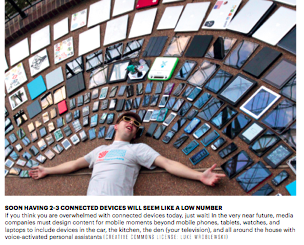
The fraudulence of ‘slogan strategies’
Over the last several years, magazine media have grasped almost desperately at “slogan strategies”. Initially we tried “digital-first”. That sounded good, but it was fraudulent because it amounted to no more than putting print content online before it appeared in print, where it belonged based on what it was.
Then “responsive design” appeared to be the answer. But responsive design, while making sites look good on mobile devices, did absolutely nothing to ensure that the content met the unique needs of mobile consumers and the unique properties of mobile devices.
“If you think responsive web design meets your customers’ needs, you had better think again (and think fast),” said CIO magazine senior writer Tom Kaneshige on the CIO blog. “Mobile users are on the move and want answers quickly. Treating mobility like an extension of your web presence won’t cut it.”

“I think we are well beyond the point where we are making websites ‘mobile-friendly’ or ‘mobile-ready’,” wrote Pole Position Marketing president Stoney deGeyter on the Marketing Land blog. “Doing so still places the focus on the desktop, with mobile design and optimisation just being an add-on. If that’s still the way you’re looking at it, you have already fall- en behind.”
Mobile-“first is just a way station for desktop content The next solution was “mobile-first”. But it, too, was fraudulent. Mobile-first simply put content ultimately destined for the desktop on a mobile device first. The content was not specifically designed or created for the mobile platform or mobile-need moment. It was desktop content making an awkward visit to a mobile device be- fore getting to its intended destination: the laptop.
Lately, “mobile-only” has attracted some proponents. While it is much closer to what we need to be doing, the phrase sends some magazine media people, especially legacy media folks, into paroxysms of panic. They mistakenly think “mobile-only” means “only mobile” — abandoning desktop and print. It does not, but the explanation takes too long and it confuses too many people.
“Mobile-only” also seems to de-emphasise the continued importance of both print and desktop. Millions of people still use both platforms, and print continues to deliver significant profits.
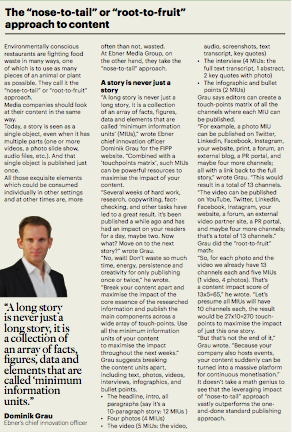
Focusing on devices instead of behaviour
The trouble with latching on to any of the slogan strategies — mobile-first, mobile-only, and even digital-first — is that they place “too much emphasis on the device and not enough on the behaviour,” wrote Gartner marketing research director Ewan McIntyre on the Gartner blog. “Sure, mobile is an important touchpoint, but it’s one of numerous online and offline touch-points that your customers and prospects will encounter with your and your competitors’ brands each and every day.
“‘Heavying-up’ on investment in the mobile experience, at the expense of other touch-points, is counterproductive,” wrote McIntyre.
“The reality is that customers don’t think about devices, they simply think of the task they need to complete at that specific instance, and how best they can complete it,” wrote McIntyre.
Additionally, a majority of consumers use multiple devices. For example, 60 per cent of UK adults use at least two devices per day, and nearly 25 per cent use three, according to a recent Direct Marketing Association report. And that’s not counting the millions who still read a print product.
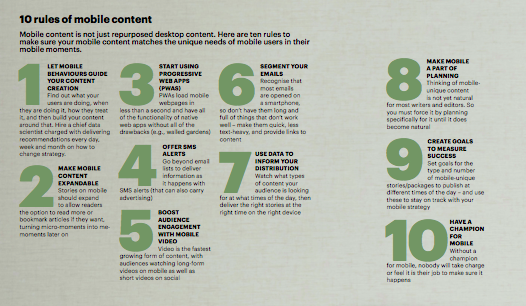 Soon, two or even three devices will seem like a low number. In the very near future, media companies must design mobile moments to go beyond mobile phones. “Think about how to engage your customers on their watches, TVs, computers, cars, and all the other devices they regularly interact with,” said Forrester analyst Jennifer Wise in her Postback mobile marketing convention keynote last summer.
Soon, two or even three devices will seem like a low number. In the very near future, media companies must design mobile moments to go beyond mobile phones. “Think about how to engage your customers on their watches, TVs, computers, cars, and all the other devices they regularly interact with,” said Forrester analyst Jennifer Wise in her Postback mobile marketing convention keynote last summer.
It’s about moment- and device- appropriate content
With life in the age of the Internet of Things fast approaching (think Amazon Echo and Google’s Alexa), it’s clear we must completely re-examine this whole content strategy labelling thing.
So, let’s abandon the clever but narrow “-first” and “-only” suffixes.
Let’s start talking about content that is appropriate for and relevant to the consumer’s needs at the moment, as well as the format (video, text, photo, etc.), and platform (mobile, desktop, wearable, print, etc.) that work in the context of that moment or “use case”.
If we really need a label, let’s start calling it “Precision Content”.
What is precision content?
I admit that title is not sexy. It probably won’t become a hashtag. Nor is it a reassuringly simple, black-and-white directive title like “Mobile-First”.
But readers’ content needs are neither simple nor do they lend themselves to easy solutions. Readers’ content needs are diverse, they change throughout the day, they are situation-specific, and they are both restricted and enhanced by the platform the reader is using at the moment.
Sexy or not, a “precision content” approach would solve the two biggest con- tent questions:
1. What content do our readers want at what moment on what device and in what form?
Your reader data shows you very precisely what your readers’ needs are: What types of content they consume at what times of day on what devices. That data should influence your content creation and publishing decisions: What you create, when you post it, and where you publish it.
2. How do we best assemble information (tell the story)?
When we first consider a story idea, we should not declare that it is a mobile story or desktop story, but look instead at how best to tell it across platforms and at different times of the day: What formats, what platforms, what media will fit which reader-need moments and platforms? ”Not everything that goes into the desktop version needs to go into the mobile site, or vice versa,” wrote Quartz product director Priya Ganapati on the journalism site NiemanLab.
A single story can be best told with different elements with each “use case” in mind: For example, for mobile the offering might include short and sweet headlines and summaries with photos, videos, lists, interview snippets, polls, augmented reality and/or virtual reality elements. For desktop: in-depth, layered content with interactive elements, big-display features (slide shows, detailed maps, infographics, etc.), chats, interactive video, full interviews, courses/webinars, surveys, games, ecommerce, user-generated content, etc.; and for print, big photo spreads, exquisite design, in-depth content, and connections back to digital.
“It’s about screens now, not just mobile-first or web-first” wrote Inkoniq founder and CEO Rajesh Kumar in his LinkedIn column (Inkoniq is an India-based user experience design company). “Desktops and notebooks are still ruling our workplaces and smart TVs are making our screens larger than ever,” Kumar wrote. “In the US, people spend over 444 minutes looking at screens every day. Out of which, 151 minutes are spent on smart- phones, 147 minutes on watching TVs, and 103 minutes on desktops/laptops, according to the Internet Trends Report [from Kleiner Perkins Caufield & Byers partner Mary Meeker].
“In order to analyse the [content] requirement better, we have to track people and behaviour across all screens,” he wrote. “We have to think about the complete picture and track the user’s entire digital journey.”

Time to change story conceptualisation
Editorial departments therefore must change their approach to story conceptualisation and planning to answer those two primary questions I mentioned earlier: What stories should we tell, and how can we best tell them?
The first question — what stories should we tell — is not the slam dunk it might appear to be. Editors might smirk and say, “Stupid question: The stories we should tell are the stories we decide are the best or most important ones!” Well, yes, the editor’s instinct is still very important. The most successful magazine media have often risen to the top riding the instincts of a great editor and staff.
But editors face tough times: They have never had the intense competition and financial pressures that challenge them today. On the other hand, they also have never had the benefit of the massive amounts of reader data that they have access to today. That data is practically a blueprint for success.

Editors should be hungry to see, analyse, and employ reader data in making content decisions. By combining the editor’s instincts and the data, the answers to the content questions should be clear, or at least much less murky.
Readers want content to answer questions, enlighten, and entertain them. And they want certain content in certain forms at certain times of the day. For example, a reader commuting to work probably wants quick, concise, easily digestible information on mobile in the morning and again just before going home with more in-depth content later in the day. For each persona served by a magazine media, content must be planned around that persona’s needs and use cases.
Unfortunately, few magazine media editorial departments do that.
That is no exaggeration.
In consulting with publishing companies around the world, we see most editors planning content without considering the very visible behaviour of their readers. Too few editors know the kinds of content, the hour of the day, and the platform where their readers are consuming content.
Publishing schedules have not changed to match consumption patterns
We are continually amazed at how many editorial departments still work 9-5 and still publish most of their content at the end of the day.
Editors now might add a video or a slide show to a story, but it does not seem to occur to too many of them that they might build use-case or “precision content” packages for particular platforms and times of the day when the user has different needs and is using a particular device (all of which editors can learn by analysing their user data).
I have yet to encounter an editorial department that has created a publishing schedule designed to deliver content at the times and on the platforms that their readers have proven to prefer. When we compare a publisher’s actual posting times with the times when their readers are on their website, there is rarely any correlation.
A majority of stories are published at hours when most readers are not online (late afternoon). When readers are online (especially early morning), few new stories are being posted. In the mornings, too many readers find content that is still there from the night before or that was written the day before but simply scheduled to automatically post at 5 am. That content is also rarely tailored to the morning “use case” — quick updates, information they need to know to help them get through their day or just to look smart first thing in the morning.
As more and more people move to a mobile-only relationship with content creators, the need to provide “precision content” on mobile will become more and more essential.

“This is more than just a shift in time spent; it’s actually a fundamental shift in how (consumers) engage and what their expectations are,” Forrester analyst Jennifer Wise said in her Postback keynote. “It’s the expectation that I can get what I want in my immediate context and moments of need.”
“The brands that combine consumers, data and technology will be the ones to win mobile moments,” wrote Kim Morrison, senior content marketing strategist at mobile marketing company Tune, on the Tune blog. “Marketers must get to know their consumers by capturing the best possible data on their interests, locations and preferences. They should use that data to create actionable, customised messaging for a variety of devices in the exact moments their customers need them. The companies who successfully integrate consumers with data and technology will be the ones who come out on top.”
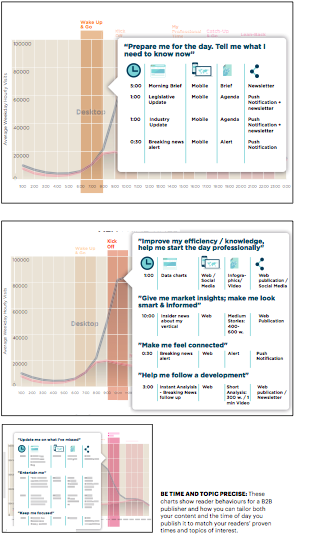
More than 80 per cent of audience growth is in mobile
That battle to come out on top is increasingly happening on mobile.
Seventy-five per cent of internet use will be on a mobile device in 2017 — up from 68 per cent in 2016, according to a mobile advertising forecast looking at 60 countries released last autumn by Publicis’s Zenith unit.
More than 80 per cent of audience growth is in mobile, according to the Magazine Media 360 Brand Audience Report (from MPA, the US association of magazine media). Of the 89 US magazine media brands that experienced audience growth, 83 per cent of those brands saw an increase in their average mobile web audiences. To emphasise the point, the report also found that of the 43 brands whose total audience declined, 60 per cent reported declines in mobile web audiences.
When it comes to ecommerce, a majority of that traffic is conducted on mobile devices, a trend that is growing 48 per cent faster than commerce overall, according to statistics com- piled by cyber security firm Radware.
Increasingly consumers are using only their smartphones to access the Internet. In the US, fully one-fourth of all consumers are mobile- only consumers, according to mobile marketing firm Smart Insights.
While mobile usage is skyrocketing, all other media usage is declining. In mid-2016, Zenith Optimedia forecast that all media, including desktop internet, would decline by 3.4 per cent in total in 2016. Breaking down traditional media, Zenith projected a television decline of 1.5 per cent, radio 2.4 per cent, newspapers 5.6 per cent, and magazines 6.7 per cent.
Mobile users share twice as much
Mobile users are almost twice as likely to share content as are desktop users, according to a recent study by ShareThis.
“If your social sharing buttons work when displayed on your desktop but not on mobile, you’re missing out on about two-thirds of your online branding potential,” wrote Stoney deGeyter on MarketingLand.com. “That’s a lot of people who won’t be seeing your content, simply because your content isn’t shareable from a mobile device.”
Then there’s the developing change in how Google does index search. “The fact that mobile searches have topped the number of searches from desktop devices in many countries around the world is… why Google has decided to change the point of view and start gauging the websites in their index with primarily mobile users’ interests in mind,” wrote Pete Campbell, managing director of London-based marketing firm Kaizen, on the StateOfDigital blog.
“In technical terms, it means that the main user-agent crawling the website will be mobile and the content that is accessible to the mobile crawler will be the one that will be considered for ranking,” wrote Campbell.
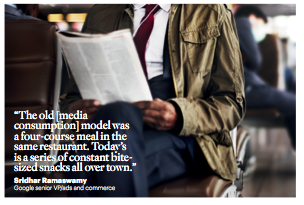
Most editors still prioritise desktop
And yet, “it’s still astounding how many major brands (including possibly our own) favour the desktop first and prioritise mobile web second,” wrote TechCrunch writer Darrell Etherington on the TechCrunch blog.
So how do you create precision content that will succeed across the universe of mobile moments, formats, and platforms?
You start by first checking your speedometer! Your page-load-time speedometer, that is.
“Having a slow site on mobile is a death knell,” wrote media consultant JT Ripton on the GoDaddy “Garage” blog. “When a site takes more than three seconds to load, 57 per cent of mobile users will abandon it. What’s more, 80 per cent of these visitors will never come back. AppDynamics also found that 86 per cent of people in the US had deleted or uninstalled an app because of performance issues.”
There is no point in spending time and money to create the world’s best mobile content if it does not load fast enough.
“The key to good mobile performance is solid use of content delivery networks (CDNs) that cache content close to where users are re- questing the data,” wrote Ripton. “CDNs use scalable hosting solutions that can meet spikes in demand, with focused attention on the load times of all external libraries, embedded code and other components that might slow down a site on mobile.”

How to check your page-load speed
There are several tools to check loading speed, including Google’s own free Mobile-Friend-ly Test as well as the free tool GTMetrix and the fee-based tool Pingdom.
To speed their page-load times, magazine and news media companies are beginning to adopt a Google technology called Progressive Web Apps, which is reported to load mobile webpages in less than a second. That would be a massive improvement for many media sites where pages load more slowly, at best in three to 10 seconds, but often taking much longer (several magazine media story pages we tested took more than 20 seconds to load). Care to hazard a guess as to how many readers have the patience to wait that long?
One media company leading the PWA charge is the Washington Post. “Our goal was to create the fastest mobile news site possible,” Post chief technology officer Shailesh Prakash told the Wall Street Journal. “A lot of publishers have spent time making their apps very fast, but the mobile web is where the growth is. It’s where the action is.”
The Post’s breakdown of traffic sources probably mirrors most media companies these days. Almost three-quarters (70 per cent) of the Post’s traffic comes from mobile devices and two-thirds of those visitors are using the Post mobile website instead of the app, according to Prakash. The new speedy PWA technology also contributed to a massive increase in pages per visit (500 per cent) compared to the earlier version, Prakash said.
Google also released its Accelerated Mobile Pages in late 2015 that many media companies are now using to speed page-load times. Once you’ve fixed any page-loading speed problems, you can then move on to creating great mobile use-case content.
First, you will want to match content to reader-need moments.
Google has a distinct opinion on how that should work. “Our research has uncovered a fundamental change in the way people consume media: The old days of predictable, periodic media sessions have been replaced by numerous short bursts of digital activity throughout the day,” wrote Google senior VP/ads and commerce Sridhar Ramaswamy in the Wall Street Journal.
“The old model was a four-course meal in the same restaurant. Today’s is a series of constant bite-sized snacks all over town,” he wrote. “Some of these hundreds of moments per day are when people are checking the time, texting with a spouse, or catching up with friends on social media,” wrote Ramaswamy. “But then there are those moments that really matter — the I want-to-know moments, I want-to-go moments, I want-to-do moments, and I want- to-buy moments. They matter to consumers and they matter to brands.”
Mobile moments are intent-rich moments
“They are intent-rich moments where decisions are being made and preferences being shaped,” Ramaswamy wrote. “We see them constantly, across billions of monthly searches, billions of hours of videos watched every month, billions of interactions with various sites and apps. These aren’t just people inattentively tapping things into their phone; they rather are the new battleground for hearts, minds and, with them, the dollars their attention brings along.”
The types of content being consumed on mobile devices is growing and might sound a lot like desktop content.
“Your customers are using their mobiles to read long-form articles and blogs, stream TV shows and music, search for entertainment on long commutes and conduct research for work,” wrote Annie Peachman, content strategist at integrated communications strategies Spectrum Group, on the company blog. “But this doesn’t mean they want to see exactly the same content they’d consume on their desktop.
Think of mobile as a type of behaviour
“Mobile is no longer about devices; it needs to be thought of as a type of behaviour,” Peachman wrote. “When we engage with content on our phones we’re swiping and tapping, switching between apps and being interrupted by notifications. To truly engage mobile users, everything about the customer experience should reflect this behaviour: Content must be hyper-relevant, easy to navigate and customisable.”
“Create content that people can engage with quickly when they’re on-the-go, but expand to see more of when they have the time,” she wrote. “Use headings and sub-headings to break up text and cut out large visuals that use up band- width. Most importantly, make it easy to swipe or tap to see the full article or find more relevant information — don’t include everything in the one place. Highlight important facts, quotes or insights that you want people to remember.”
In addition to swiping and tapping, mobile users are also getting accustomed to talking to their phones.
“Increasingly, mobile users prefer to talk to their applications instead of tapping them,” wrote media consultant Ripton on GoDaddy’s blog. “Enabling click-to-call voice or video calls within your app or website is easier than you might think. There are several click-to-call SDK’s (Software Development Kits) that provide you with a few lines of code and easy to follow directions.”
Media designers say the powers (and limitations) of smart phones inspire them and open up their minds to new and more creative ways of telling stories, according to interviews by Shan Wang, a writer for journalism site NiemanLab. “There can be rich opportunities that come with these devices: the gyroscope that senses tilt and movement, easier geolocation, the built-in camera,” Jessica Yu, global head of visuals at The Wall Street Journal, told Wang. “All platforms have their unique opportunities.”
Use mobile capabilities in storytelling
Mobile devices “have these capabilities built into them, so how do we use it in our story- telling?” Len DeGroot, director of data visualisation for the Los Angeles Times, told Wang. “The mobile phone comes with a slate of different features and user behaviours that designers and developers can exploit and need to cater to.
“There are definitely cases where thinking in a mobile format helps, and provides a nice way to structure information in smaller bite sizes,” Bloomberg designer Mira Rojanasakul told Wang.
When it comes time to think about content, then, editors and writers must radically revise their thinking. They must think about stories as packages of “precision content” created to meet specific reader needs using the unique strengths of each platform and timed to be published at distinct times readers have shown they want it.
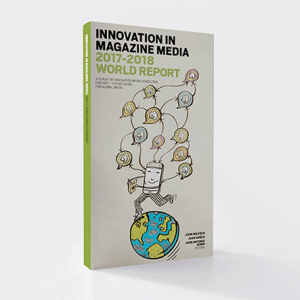
This article is one of many chapters published in our book, Innovations in Magazine Media 2017 World Report.


